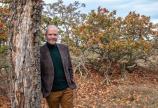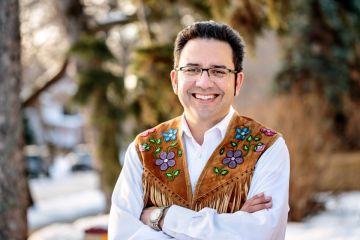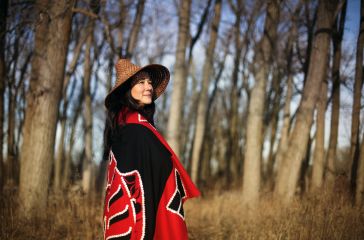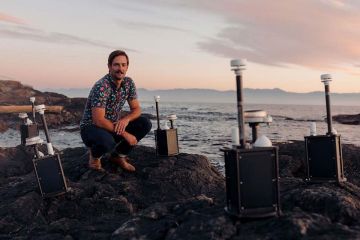Hope and story
- Michael Kissinger
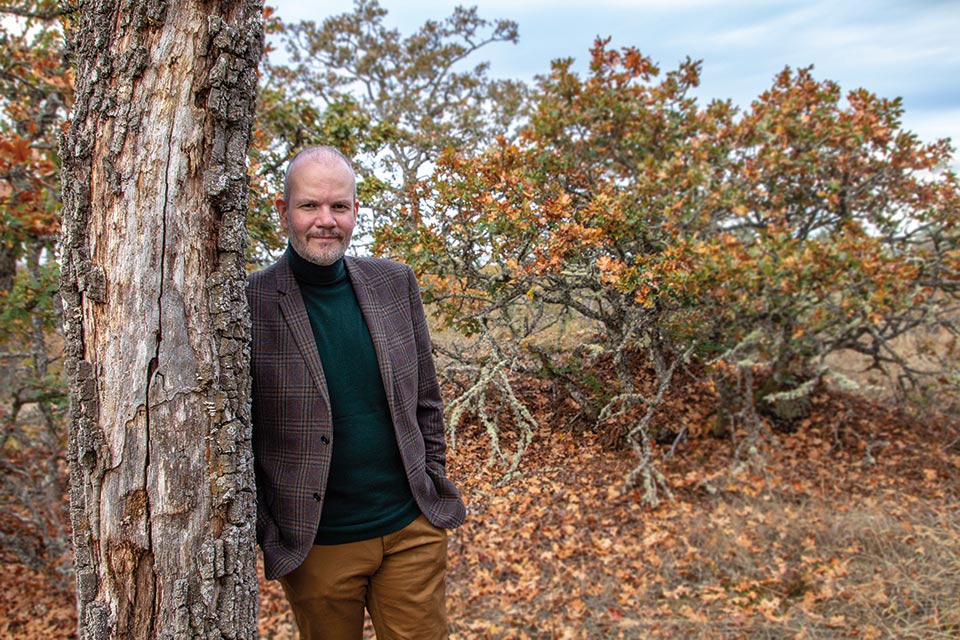
Growing up in the 1980s, Sean Holman found solace in fantasy. Role-playing games like Dungeons & Dragons offered an escape from the reality of school bullies and isolation—an alternate narrative, limited only by his imagination, where the playing field was level and justice could be meted out with the roll of a 20-sided die.
The University of Victoria history and political science graduate still enjoys the creativity of gaming, going so far as inventing his own D&D-inspired game called Yore & Gore, which he plays online with friends across the country.
“Interestingly enough, it’s set in a post-apocalyptic environment that works from the premise of an early Industrial Age war that included a chemical gas causing a long-term apocalypse that also resulted in the degradation of technology,” Holman says with a grin.
The far-reaching implications of environmental disaster and what society can do about it are reoccurring themes in Holman’s new role at UVic as the Wayne Crookes Professor of Environmental and Climate Journalism. The long-time investigative reporter has been putting in 15-hour days since returning to campus last year and launching the Climate Disaster Project. The ambitious, multi-pronged initiative will see students and faculties from 13 post-secondary institutions around the world tackle what Holman says is the defining problem of our times. The project aims to collect and compile firsthand accounts of people who have survived climate disasters and, through the sharing of these stories, “build communities of action” around climate change.
However, it’s not a lack of information that led us to the dire situation we find ourselves in today. It’s the way information around climate change has been conveyed, argues Holman, who’s especially critical of media coverage on the topic.
“We talk about it as an environmental issue. We talk about it as a political issue. We talk about it as a large-scale issue. But we really have failed to humanize, individualize and collectivize the experience of climate change… so can we feel less alone, and in that less-aloneness take action.”
—UVic Crookes Professor of Environmental and Climate Journalism Sean Holman
Taking on climate change and the role of the media is no easy task. But Holman has never been one to back down from a challenge.
Fighting back against bullies
A self-described “introspective kid” who grew up in Kamloops, Kitimat, Prince George and Victoria, Holman says his grade-school years were defined by bullying. He was picked on by the popular crowd, didn’t have any friends and had an adversarial relationship with his teachers, whom he viewed as dictatorial.
But his outsider status also made him a keen observer of human behaviour and power dynamics. “And very highly attuned to risk,” he adds. “A lot of the work of journalism is imaginative empathy and risk assessment—being able to predict what’s going to happen before it’s going to happen. And the experience of being bullied very much sharpened that… It’s trauma response.”
When it came to dealing with bullies, Holman’s parents, both UVic graduates, stressed the importance of fighting back. “I was able to get efficacy from that in a way that could have been very disempowering otherwise,” he says, sitting outside UVic’s Fine Arts Building and dressed in hiking shoes, khaki shorts, tropical shirt and straw fedora reminiscent of a more eco-conscious Hunter S. Thompson. “So when I came to choose a career, from a psychological standpoint, essentially what I was doing as an investigative journalist was holding the bullies and teachers to account—just in the form of politicians.”
After high school, Holman enrolled in UVic for an undergrad in history and political science, with aspirations of becoming a war correspondent or a diplomat. The film The Killing Fields, about a New York Times reporter covering the civil war in Cambodia, had a profound impact on him, he recalls. A television commercial for Time magazine that played a montage of historical events to the Byrds’ “Turn! Turn! Turn!” was also memorable.
“History was my first love, and journalism is the first draft of it,” Holman says. “Combined with my experience of bullying, that was the stew that led me to journalism.”
A UVic course in military history taught by Dr. David Zimmerman also proved formative. Holman recalls the thrill of getting to pore over primary-source material from Joint Chiefs of Staff during the Second World War and writing an essay about what he had learned. He enjoyed every minute of it. “I loved going to the source, and journalism is a lot of that.”
While at UVic, Holman also briefly served as news director at CFUV and became involved in youth politics in the form of the Federal Young Liberals, where his cohorts were a “Murderers’ Row” of soon-to-be Liberal insiders and strategists—including many who became embroiled in the BC Rail scandal of 2003. “That ended up cinching it for me that I should go into journalism… And I decided I would much rather be on the outside of that—holding power to account—than on the inside of that.”
Truth to power
After graduating in 1999, Holman headed to Carleton University in Ottawa for his Master of Journalism. For one assignment, he wrote an investigative piece on a fledgling internet company and was surprised to receive a C+ grade. He took the story to another professor who thought more highly of it and helped him pitch the tech editor at the Globe and Mail. The newspaper published the feature, which was one of the first investigative pieces on the controversial file-sharing service Napster. From that introduction, Holman started working as a stringer for the Globe and Mail’s tech section, followed by an internship at Dow Jones Newswires.
He returned to BC to work in government communications before realizing he would rather hold power to account than work for the institutions that wield it. He left with an insider’s knowledge of how government PR worked and a Rolodex of contacts he would rely on as he launched the online public affairs news service Public Eye—one of the first of its kind at the time. “I didn’t want to spend time climbing the ladder, so I created my own ladder.”
Holman filed mountains of Freedom of Information requests and closely examined government contracts to sniff out anything fishy. He quickly made a name for himself—and ruffled more than a few government feathers along the way. Over a 10-year period and some 6,000 stories later, with bylines in the Times Colonist, Vancouver Sun, 24 Hours and Globe and Mail, Holman’s investigative reporting would result in the departures of eight different public or party officials, as well as major policy and legislative changes.
“Whenever I went down to the legislature you were required to put on a suit. And it always metaphorically seemed to me like I was putting on armour.”
—Sean Holman
His efforts didn’t go unnoticed. In 2005, he received a Jack Webster Award—BC journalism’s highest honour—for an investigation that resulted in multiple resignations as the well as the firing of a deputy minister. In 2012, he received a special mention in the Canadian Newsperson of the Year competition for “using new and emerging media technologies to expand the number of journalistic voices in this country and to redefine the relationship between journalists and citizens.”
During all of this, Holman hosted a political radio show on CFAX 1070, taught journalism at UVic for a stint and made the documentary Whipped: The Secret World of Party Discipline, exploring the inner workings of block voting in BC politics and its impact on the democratic process.
However, the stress of breaking stories and battling the powers that be took its toll. Holman remembers looking in the mirror after a particularly gruelling day ensuring a story was airtight, and his entire left eye was full of blood from a burst vessel. “It was 10 years of doing that… every single day and it just wore on me.”
He shuttered Public Eye and took a job teaching journalism at Mount Royal University in Calgary. It was during this time he penned an open letter to mainstream media in the online news outlet The Tyee, urging journalists to start reporting climate change as an emergency.
In the widely circulated missive, Holman castigated the media’s ineffectiveness and outright dereliction of duty in properly covering and contextualizing the climate crisis. “These are unconscionable failures of journalism, nothing more and nothing less,” he wrote. “If we continue in these failures, we could be contributing to the deaths of millions.”
Problem of our times
In many ways, Holman’s open letter served as a blueprint for his Climate Disaster Project and helped punch his return ticket to UVic. He says the university’s Sustainable Development Goals align with the mandate of the project.
“It’s been wonderful,” he says about returning to Victoria, where he lives with his wife, whom he met at a UVic atheist club 15 years ago. “UVic is an extraordinary place to undertake work related to climate change. There are so many communities of action on campus that are dedicated to trying to solve what is the defining problem of our times.”
David Leach, a professor of creative non-fiction in UVic’s Department of Writing, has known Holman personally and professionally for nearly 20 years. Leach calls his friend and colleague “a connector” who possesses a boundless enthusiasm and belief in the power of journalism and storytelling to change the world for the better. “But I think Sean has also made an interesting shift when he began covering climate change more and this realization that there’s a limit to the power of journalism—that getting the facts out there… often isn’t enough to change the dialogue of public information when there’s so much going on and so much misinformation.”
Building hope and community
The proliferation of misinformation, combined with the declining state of journalism, further underlines the urgency of the Climate Disaster Project. What was once a hallowed institution has become disregarded, devalued, underfunded and increasingly under attack—the ramifications of which we’re witnessing firsthand on a daily basis, Holman notes.
“Ralph Nader used to describe information as the currency of democracy,” he says. “And maybe it never was, but what I have seen is the degradation of the value of information across society. And that has flow-through impacts on the media and democracy. Democracy is based on the idea that we will use information to make rational and empathetic decisions about the world around us. Empathetic is especially important because democracy assumes we are governing ourselves for the common wealth… the common good… And when we don’t use information that way, democracy breaks down, which is what we’re seeing, as does the role of the media.”
The climate crisis is a perfect example of the devaluing of information, he adds. “We have scientific evidence, and we have anecdotal evidence and we have firsthand evidence about what is happening to this planet, and yet the needle isn’t moving. And if it is moving, it certainly isn’t moving fast enough.”
So, what’s the solution when the science and evidence all point in the same direction, yet progress remains slow as we accept that summers will be hotter, wildfires will be deadlier, flooding more frequent, polar ice caps will continue to melt and more species will face extinction? For Holman, it comes back to story.
“I knew I was going to be situated in a writing department in a Faculty of Fine Arts, so what I was really interested in was how can story help at this crucial moment in time,” he says. “And story is really the only thing we have to build community. And community is the only thing we have to build hope.”
Photos
In this story
Keywords: alumni, writing, sustainability, climate
People: Sean Holman
Publication: The Torch

